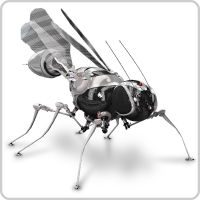Dialogues between Biology and Engineering
What are the behavioral algorithms employed by even a simple organism like the fruit fly?
Answers to this question will enable the generation of artificial systems able to successfully and robustly navigate a complex world.

One means of identifying the structure of an unknown system is to probe it with controlled stimuli. The output or behavior of the system can then serve as a dataset for exploring potential underlying mechanisms.
This philosophy guides our study of how behaviors are produced in response to chemical environmental cues or smells. While flies can be capable of detecting many hundreds of odors, innate responses to these stimuli are thought to be more restricted to degrees of valence, namely attraction and aversion. We aim to understand the algorithms that underlie these broad behavioral descriptors.
To do this, we are quantitatively studying freely moving flies as they respond to odors in a custom built automated experimental system. With these data we are exploring the behavioral strategies of odor avoidance and attraction as well as the origins of individual variability in these behaviors.
We are using these data to generate artificial behavioral controllers and to understand the evolution of robust, multifaceted behaviors in intelligent systems.
This project is performed in the Laboratory of Intelligent Systems (EPFL) in collaboration with the Benton Laboratory (UNIL).
We have open positions for students at all levels. Please contact Pavan Ramdya.
Publications
Please note that the publication lists from Infoscience integrated into the EPFL website, lab or people pages are frozen following the launch of the new version of platform. The owners of these pages are invited to recreate their publication list from Infoscience. For any assistance, please consult the Infoscience help or contact support.